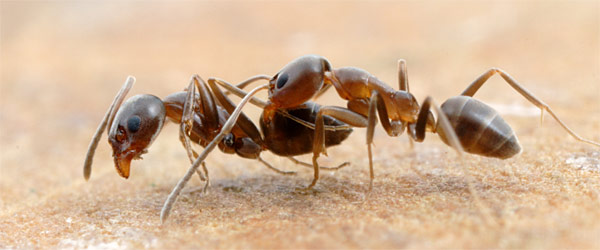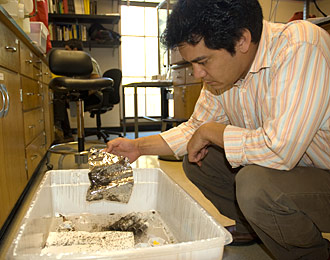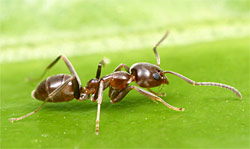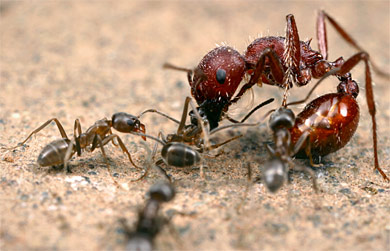 Argentine ants in their native habitat engage in inter-colony warfare, keeping their numbers in check. In introduced ranges, these ants are often genetically similar, allowing them to form supercolonies. Researchers have now isolated and synthesized chemicals used by Argentine ants to distinguish friend from foe. (Photo copyright © Alex Wild)
Argentine ants in their native habitat engage in inter-colony warfare, keeping their numbers in check. In introduced ranges, these ants are often genetically similar, allowing them to form supercolonies. Researchers have now isolated and synthesized chemicals used by Argentine ants to distinguish friend from foe. (Photo copyright © Alex Wild)When ants attack: Researchers recreate chemicals that trigger aggression in Argentine ants
| 27 October 2009
BERKELEY — Experiments led by researchers at the University of California, Berkeley, have demonstrated that normally friendly ants can turn against each other by exploiting the chemical cues they use to distinguish colony-mates from rivals.
The new study, to be published Wednesday, Oct. 28, in the open-access journal BMC Biology, sheds light on the factors influencing the social behavior of the Argentine ant, Linepithema humile, and provides hope for a new tactic in controlling the spread of this invasive species.
 Neil Tsutsui, associate professor at UC Berkeley's Department of Environmental Science, Policy & Management, inspects a shipment of Argentine ants in his lab. (Sarah Yang/UC Berkeley photo)
Neil Tsutsui, associate professor at UC Berkeley's Department of Environmental Science, Policy & Management, inspects a shipment of Argentine ants in his lab. (Sarah Yang/UC Berkeley photo)"Almost all living organisms use chemical recognition cues to some degree, but it is particularly common among ants and other insects," said evolutionary biologist Neil Tsutsui, UC Berkeley associate professor of environmental science, policy and management and the study's principal investigator. "Surprisingly, it wasn't until this work that the specific chemicals used by Argentine ants to identify each other were isolated and tested."
Native to South America, the Argentine ant has taken hold in numerous countries worldwide, including Australia, Japan and the United States. In California, the ants are pervasive, pushing out native ant species and wreaking ecological havoc along the way. The Argentine ant has been blamed for exacerbating problems with some agricultural crops in the state, and for the decline of the coast horned lizard, which feeds exclusively upon the native ant species decimated by the invader.
In their native habitat, Argentine ants use their aggression to engage in inter-colony warfare with each other as they compete for resources, a behavioral trait that biologists credit for keeping the ants' numbers in check. Colonies tend to be small, typically measuring a few meters to a couple of hundred meters wide.
 The Argentine ant is a highly invasive species that has spread to more than a dozen countries around the world. (Photo copyright © Alex Wild)
The Argentine ant is a highly invasive species that has spread to more than a dozen countries around the world. (Photo copyright © Alex Wild)"The striking thing about these Argentine ants in introduced ranges is that – with few exceptions – they are essentially functioning as a single, geographically huge supercolony," said Tsutsui. "If you take ants from San Diego and put them next to those from San Francisco, they'll act like they've known each other all their lives. They are part of a massive supercolony that extends hundreds of miles, nearly the entire length of California."
The UC Berkeley researchers worked with study co-authors Robert Sulc and Kenneth Shea from UC Irvine to narrow down and synthesize seven chemical molecules that trigger aggressive behavior among the Argentine ants. They also used two "control" chemicals not linked to fighting behavior. The "enemy" compounds were similar in that they were all long chains of hydrocarbons with one to three methyl groups attached.
 Argentine ants attack a much larger harvester ant. The Argentine ants, native to South America, have displaced native species of ants in California, threatening the coastal horned lizards that rely upon the native ants for food. (Photo copyright © Alex Wild)
Argentine ants attack a much larger harvester ant. The Argentine ants, native to South America, have displaced native species of ants in California, threatening the coastal horned lizards that rely upon the native ants for food. (Photo copyright © Alex Wild)"The 'enemy' chemicals generated significantly greater instances of flared mandibles, biting and other attacking behavior than did the control chemicals," said study co-lead author Ellen van Wilgenburg, a post-doctoral researcher in Tsutsui's lab at UC Berkeley. "We also saw higher levels of aggression when we increased the concentration of the chemicals and when we combined some of the chemicals together."
Despite this finding, Tsutsui cautions that significant barriers must be overcome before a pest-control substance based upon these chemicals is ready for the market. "We are still in the process of understanding how these chemicals control social behaviors in ants," he said. "These are custom chemicals that are very costly to synthesize at this stage. We are still a long way off from having large enough quantities to deploy in the field, or even knowing if these chemicals can control populations in the field."
The other co-lead author of the study is Miriam Brandt, a former post-doctoral researcher from Tsutsui's lab.
The U.S. Department of Agriculture, the California Structural Pest Control Board, the Defining Wisdom Program of the University of Chicago and the National Science Foundation helped support this research.

